1 organization as domination
Organizational theory could benefit from a hostile perspective;
it has been altogether too accommodating to organizations and their power.
(Perrow 1979)
part 1. when we think of organizations, what comes to mind?
you might think of your family, your friend group, your kindergarten classroom, your middle school, a club you belong to, places where you’ve worked… you might think of the mall, the bank, the grocery store, the public library, the community center… or maybe you think about the federal government in Washington DC, city hall in your hometown, or about grassroots organizations and social movements that you are part of…
all of these organizations (and more!) make up and impact our lives. in them, we are more than just individuals–we are connected to others, we have a bigger purpose, a shared identity. far more than just places on a map, organizations affect how we see ourselves and others. organizations send signals–they let us know who is welcome and who belongs (and who does not), who is affirmed and valued (and who is not). they let us know what position we hold in the hierarchy, whose voice matters (and whose does not), and they give us a sense of worth (or take that sense of worth away from us).
exercise 1. close your eyes, take a moment, and recall how an organization at some point in your life made you FEEL.
- first, think of a wonderful organizational experience that left a positive mark on you. next, think about a hurtful organizational experience that still stings to this day, perhaps years (or decades) later?
- what made that positive experience wonderful? what made the hurtful experience sting? which left a STRONGER imprint on you? the positive or the hurtful?
in later chapters, we will reflect upon the beautiful aspects of organizations–collective spaces that invite, value, and heal; that liberate, empower, and challenge us to do our best; and that make us feel excited, hopeful, and engaged.
but before we get to the beautiful, i ask that we start with the ugly. before we get to the kind of organization that we would love to inhabit, i ask that we start with the kind of organization that we are too often forced to inhabit–collective spaces that make us feel small, unwanted, barely tolerated, marginalized, and excluded. i do so because it seems to me that, at least in the present moment, these kinds of oppressive organizations dominate. we find them in our families, our schools, places of work, in government, and even in the grassroots organizations we form to challenge that domination.
part 2. Domination, The Metaphor
The idea of Org-as-Domination can be a useful frame work to examine the darker underbelly of organizations, and help us seek out alternative and less oppressive systems of organization. Domination is defined by The Miriam Webster Dictionary as “the exercise of control or influence over someone or something, or the state of being so controlled.” To exercise dominance, one must have an element of power, (ie: control/influence) and use it to control a person or a group. Historically, dominance has been used as a tool for the powerful to manipulate and control the less fortunate with note-able examples such as global settler colonialism, tyrannical governments, and now in the modern setting: Organizations.
Domination as a metaphor for understanding orgs also connects well to the Marxist theory of modes of production. This was Marx’s outline of how the powerful use their control of means of production to also control the working class. Notably, a key concept of his theory was that the accumulation of capital was the drive behind all production. Growing with capitalism throughout the 20th century, exploitation of workers has now reached new and modern conclusions, with multinational companies extracting labor and resources from desperate and disparaged communities.
Two organizational thinkers, Gareth Morgan (based in the UK and Canada) and Chris Grey (based in the UK), give us a framework for understanding oppressive organizations–we can think of these as organizations-as-instruments (or tools)-of-domination. below you will find my interpretation of domination on two levels.
the first diagram represents domination as a global system rooted in the “relentless,” “hyper-competitiveness” and “hyper- stress” of what Grey (2013) calls “the new capitalism.” in the new capitalism, human beings, communities, and the environment have no intrinsic value beyond that which brings corporations profits. This is an evolution of the same Capitalism which Marx warned would always end in exploitation and control. Now, when a cheaper source of labor and materials opens up, or a local or national government lowers corporate taxes and guts regulations, “lithe” and “mobile” organizations respond “rationally” by following where profits lead. Although it’s not hard to guess what is left behind: pollution, unemployment, a community’s shrunken tax base, despair, companies and stockholders see the capital gains involved in these actions and reinforce the idea that this is rational and positive, disregarding the human and environmental externalities.
“Actions that are rational for increasing profitability may have a damaging effect on employees’ health. Actions designed to spread an organization’s portfolio of risks… may spell economic and urban decay for whole communities of people who have built their lives around that industry: What is rational from one organizational standpoint may be catastrophic from another” (Morgan, 330).
Seeing organizations-as-tools-of-domination reveals just how easily people and places can be tossed to the side, “thrown away like empty orange peels when the organizations [and corporations] they serve have no further use for” us (Morgan 2006, 298).
the second diagram depicts a typical organization structured around domination. This diagram shows the top down profit-driven pressure that ends up pushing the detrimental externalities onto the workers. There are lots of ways that organizations reproduce the toxic domination that we find in society, culture, politics, and the economy. after all, organizations are microcosms of and “inseparable from” the larger context (Grey 2013, 105). When that larger context is based on domination by the select few at the expense of the majority, we will naturally find this same unhealthy model of relations in our organizations (Morgan 2006). As Morgan points out, “there is an element of domination in all organizations” (2006, 293), including “otherwise excellent organizations” (300). This means that even the most well-intentioned, thoughtful organizers and organizations may end up hoarding power and resources, resorting to violence to maintain the status quo, and falling back on rigid hierarchy/authoritarianism in which those ‘at the bottom’ are marginalized by and subject to the whims of those ‘at the top.
Morgan outlines three types of domination, all of which are relevant to the organizational context:
-
-
-
-
- Charismatic domination: legitimacy grounded in faith in the persons ability
- Classic domination: tradition or history or birth enables dominator to dominate (power x culture)
- Rational-legal domination: bureaucracy enforces domination by a series of written codes and rules
-
-
-
While rational legal domination may seem like the most familiar, classic domination is also very common in the organizational context. Corporate elites and governments across the world are well positioned to pass power and control down through their internal mechanisms (ie: familial inheritance and behind the scenes control of corporations by elites) The culture of domination is highly engrained into many of these apparatuses, and by consolidating power in this way, elites keep the working class sectors of society from raising their status, benefits, or autonomy.
“many of these organizations, especially in investment banking, have been characterized by highly aggressive and competitive cultures…. embodied the spirit of new capitalism: the individualistic, financially-driven, winner-takes-all and lunch-is-for-wimps ethos of neoliberalism… such organizations seem to valorize a kind of masculinist, testosterone-fuelled behavior—whether on the part of men or women, though many of the organizations in question are also male-dominated” (114).
part 3. a personal story
Growing up in Tennessee and later Southern California in the 1980s, I saw domination just about everywhere in my life. My family was structured around patriarchy, and I was taught that men by virtue of being men had power that they could and did wield over women, too often in emotionally abusive and physically violent ways. Step-fathers came and went, each different in the details but basically the same tyrant in my eyes. I was taught that parents had arbitrary power over children, and that events outside of parents’ control that marginalized them at work and in the world could and did trigger the same domination-marginalization pattern in the home. I knew that a handful of people in a certain part of town seemed to deserve and got much, much more than everyone else. the message that I got from an early age was that the world was cruel, no one would save you, you had to fight for whatever you got. in short, though i did not know the word ‘domination,’ I knew how it felt and I chafed at the injustice of it. one word, ‘unfair,’ I knew all too well.
In my early years, i watched A LOT of television. it was my escape, my babysitter. The sound of others’ lives–better, lovelier, calmer, safer–that emanated from the Zenith in the living room drew me in like nothing else. as I watched, I imagined spaces where the notion of domination itself seemed unimaginable, where adults were kind and did the right thing, where they saw need and pain and met it with generosity and love. little did i know that those very images, produced by for-profit as well as non-profit media corporations, were themselves instruments of domination.
On saturday mornings, in between cartoons, i watched public service announcements that I thought at the time were good things, valuable things worth knowing if I paid attention and was willing to learn. I imagine myself then, eating sugary sweet cereal, in front of the tv watching this public service cartoon in particular (it may be one you have also seen):
https://www.schooltube.com/media/t/1_cd0vu7lv
In it, I saw again a better imaginary world, a world that was fair and just and where good things happened to good, deserving people. that was the world i wished to inhabit! Looking back, I recognize in this 3-minute clip the hope I wanted to see as a child, but now i also see domination.
This leads me to yet another set of questions–we are nearing the end, i promise! 🙂
exercise 2. where do we see organizations-as-instruments-of-domination in our own lives?
i am wondering, after watching “i am just a bill,” do you see domination like i do? if you do, where? if you don’t, where might it be? and if you do see it, why are you primed to see it? and if you don’t see it, why might you not be primed to see it?
more broadly, can you see yourself, your family, your community located somewhere in the overarching system (diagram 1)? have you or those close to you lived, worked, or participated in an organization rooted in dominating practices (diagram 2)? what was your role or place in that system and/or in that organization–as the beneficiary of domination or the recipient of it, or a bit of both?
part 4. Imagining the Detriment of Domination
Let’s ponder what happens to us as individuals, to our society, and to our world when we live in a system based around the domination of the many by the few.
what are the material, physical, and psycho-emotional tolls of working and living in organizations that serve the interests of the few and relegate the many to subordinate and “throw-away” status?
For some answers, click on the puzzle pieces. I am sure you have additional thoughts, as well.
can you think of a song that really captures the essence of organizations-as-domination? what if we made a domination and resistance playlist?
here are a couple of offerings to begin with:
Brittany Howard – 13th Century Metal
Esperanza Spalding – Black Gold
part 5. How do we move towards a less dominating system of organization?
Key to the future of egalitarian organizations is radical imagination, and the development of novel approaches to organizational structure. One important aspect we can break down from traditional organizational management theory, is hierarchal management structures, with a goal of maximized efficiency. This has led to specialization and an overall decrease in skilled labor (to maximize efficiency) while quotas, long hours and bad conditions are contributing to the suffering of human beings in those same hyper-specialized jobs. To combat the perils of org-as-domination, we must develop systems to organize people in the workplace that breaks down traditional hierarchies. We must center collaboration and team work, as well as appreciating the knowledge and value that each individual brings to the organizational context.
once we ‘re-see’, we cannot ‘un-see’… now that we have a common framework and a language to articulate what organizations-as-domination look like, do, result in, and feel like, what next? what can we as individuals in organizations, given our position, time, energy, and resources, do to diminish domination? think small and big, short-term and long-term, near and far, at home and in the world. as an example, notice how every period in this chapter is followed by a lowercase letter? this is a perfect example of challenging the status quo of writing. a relevant action as small as this can be reimagined inside an organization to combat domination.
exercise 3. let’s commit to one act of resistance, reimagining, and/or reclaiming. what can i, you, we do to transform our organizations’ ugliest aspects into their potentially most beautiful?
- what can we do to challenge, combat, and re-envision/re-imagine organizations that oppress into organizations that uplift?
- how can we treat one another in a way that resists the temptation to give in to dominating practices?
- what organizational policies and practices can we implement to more widely distribute power, voice, and resources?
- what can we demand of others with more power, voice, and resources? and how can we build coalitions to amplify our voice, our vision, and our impact?
to begin answering these difficult, but necessary questions, and to conclude this chapter, let’s look to the words of Dr. Bettina L. Love (2019), who writes,
Theory does not solve issues—only action and solidarity can do that— but theory gives you a language to fight, knowledge to stand on, and a humbling reality of what intersectional social justice is up against…
Without theory, the moveable mountain of injustice and oppression seems too big and immobile, but theory helps us understand that our job is not to move mountains but to outmaneuver them.
add your commitment to resistance and/or reimagining below. just follow the link/instructions below, and you’ll be taken to a folder where you can upload your commitment (video, audio, text files all work):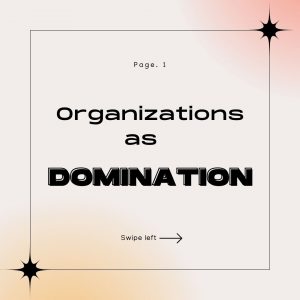
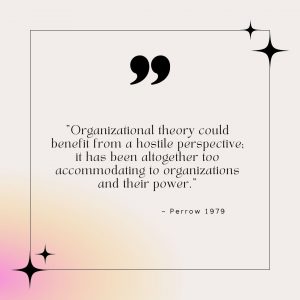



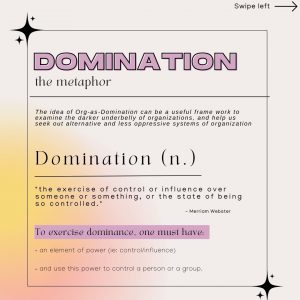


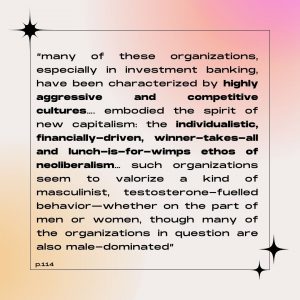

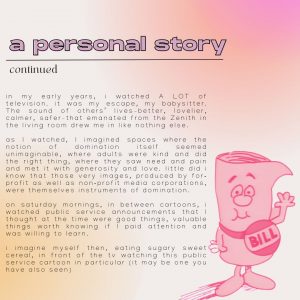
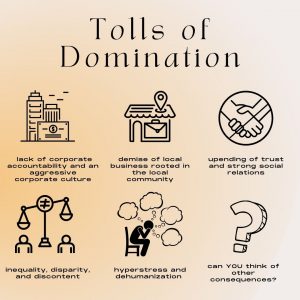
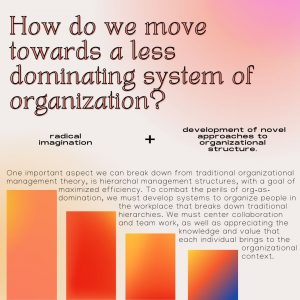
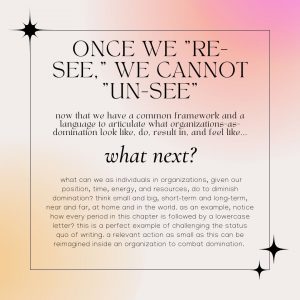
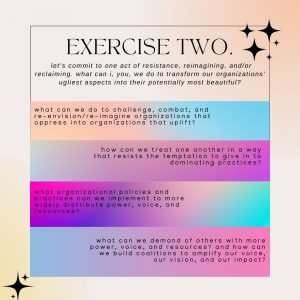
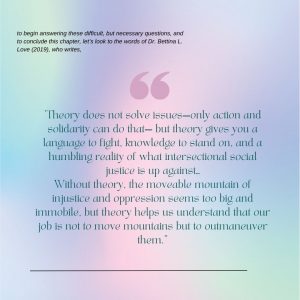
sources used in this chapter:
Grey, Chris. 2013. A Very Short, Fairly Interesting and Reasonably Cheap Book about Studying Organizations, Third Edition. [Sage]
Hughes, Langston. 1951. “Harlem.” Montage of a Dream Deferred.
Love, Bettina L. 2019. We Want to Do More than Survive: Abolitionist Teaching and The Pursuit of Educational Freedom. Boston: Beacon Press.
Morgan, Gareth. 2006. Images of Organization, Updated Edition. [Sage]
Perrow, Charles. 1979. Complex Organizations: A Critical Essay. [McGraw-Hill Humanities/Social Sciences/Languages]
chapter curators: barbara junisbai and jen beamer
Further contributors: Kourosh Ariane, Hannah Thalberg, Emery Barajas, and Baylen Altizer
- These contributors would like to thank Barbara and Jen for their work on the chapter and would like to thank classmates who have given much inspiration.
